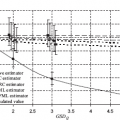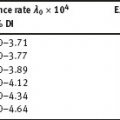3Polynomial regression with known variance of classical error In Chapter 1, it was mentioned that the binary observation model (1.2), (1.4), and (1.5) is widespread in radio-epidemiology. This binary model is the so-called generalized linear model (GLM). This means that the conditional distribution of the response y given the true value of regressor ξ is expressed through a linear function in ξ, with some unknown parameters. The linear function defines the odds function (1.4). For more information on the generalized linear models, see Chapter 4. However, a quadratic odds function is used in radio-epidemiology as well: The model (1.2), (3.1), and (1.5) serves for modeling the thyroid cancer incidence as a result of exposure by radioactive iodine: ξi is a radiation dose received by a subject i from a cohort during a fixed observation period. Positive radiation risk parameters β0, β1, and β2 are to be estimated. The presence of a negative term member in the quadratic odds function (3.1) describes the effect of burning out cancer cells at high exposure doses, which may even lead to some reduction of disease incidence. The binary regression model (1.2) and (3.1) is no longer the GLM model, because now the conditional distribution of yi given ξi is expressed through the quadratic (3.1), but not through a linear function in ξi. To get a feeling for the effect of polynomial influence of regressor on response, consider the polynomial regression model with classical measurement error. It is described by the two equations: Here, k ≥ 1 is a given degree of the polynomial (at k = 1 we get the linear model from Chapter 2), ξi is a latent variable, xi is an observed surrogate data, yi is an observed response, εi and δi are observation errors. The regression parameter has to be estimated. Introduce the vector function Now, equality (3.2) can be rewritten in the compact form We consider the structural model in which the ξi are random variables. Make the following assumptions about the observation model. (i)Random variables ξi, εi, and δi are independent. (ii)The errors εi are identically distributed with distribution (iii)The errors δi are identically distributed with distribution (iv)Random variables ξi are identically distributed with distribution The model (3.2) and (3.3), with assumptions (i)–(iv), is called normal structural polynomial model with classical measurement errors. Such models can be used, e.g., in econometrics (Carroll et al., 2006). Section 2.3 states that at k = 1 without additional assumptions about the parameters, this model (in this case being linear) is not identifiable. From here, it follows as well that at k ≥ 2, the normal polynomial model is not identifiable, because in the proof of Theorem 2.10 for the polynomial model, an additional condition for the rest of the true parameters can be imposed: In the absence of further restrictions, the normal polynomial model is determined by a vector parameter θ and the corresponding parameter set Θ: Let it be assumed additionally that k ≥ 2 and condition (3.7) is violated, i.e., the true regression function is not linear in ξi. Then the model becomes identifiable due to the fact that the distribution of the response yi is never normal. In this situation, one can construct consistent estimators of all the parameters using the method of moments (see discussion for the quadratic model (k = 2) in Carroll et al., 2006, Section 5.5.3). If we allow the degeneracy (3.7), then we need some restriction of the parameter set (3.8) to get the identifiability of the model. In this section, it is required that the measurement error variance Rarely, the ratio of error variances is assumed known. In Shklyar (2008), consistent estimators of model parameters are constructed for this case. Note that for k ≥ 2, the ML method in the normal model with assumptions (i)–(v) is not feasible (see discussion in Section 1.4.2). In particular, even under known The corrected score method was described in Section 1.4.4. Apply it to the model (3.6) and (3.3). The regression function is Since ∂f/∂β = ρ(ξ), the basic deconvolution equations (1.124) and (1.125) take the form Within the class of polynomials in ξ, the solutions are unique: where the vector function t(x) and matrix-valued function H(x) satisfy the deconvolution equations Hereafter, all the equalities for conditional expectations hold almost surely (a.s.). For the jth component of the function t(x), it holds that For an entry Hij(x) of the matrix H(x), we have Below we show that deconvolution equation (3.16) has a unique polynomial solution tj(x), and then is the only polynomial solution to equation (3.17). A solution to equation (3.16) is given by the Hermite polynomial Hj(x) closely related to normal distribution. The polynomial can be specified by an explicit formula through higher derivatives: In particular, Applying the formula for j = 2 and j = 3, we get The recurrence relation (3.21) allows us to compute consequently the next Hermite polynomials; all of them have unit leading coefficient. Let Then for all n, m ≥ 0, the equality holds: Here, δnm is the Kronecker symbol: The next Hermite polynomial property is due to Stulajter (1978). We give a simple proof. Lemma 3.1. For a standard normal random variable γ, it holds that Proof. We use induction. Denote (a)For n = 0, we have taken into account (3.20): and (3.26) holds true. For n = 1, we have, see (3.20): and (3.26) is fulfilled as well. (b)Derive a recurrence relation for expressions (3.27). If n ≥ 1, we have in view of the fact that μ + γ ∼ N(μ,1): Using equation (3.30) and identity (3.21), with j = n + 1, further we get (c)Assume that (3.26) holds true, for all n ≤ k, where k ≥ 1 is fixed. Then from equation (3.33), we will have Thus, we obtain (3.26), with n = k + 1. According to the method of mathematical induction, (3.26) has been proved for all n ≥ 0, with μ ∈ R. Corollary 3.2. In case Proof. By equality (3.26), it follows (now, both ξ and γ are independent and γ ∼N (0, 1)) that: which proves the desired statement. Lemma 3.3. In case of arbitrary Proof. Put δ = σδλ, λ ∼ N(0, 1), then by Corollary 3.2, which proves the statement of the lemma. As we can see, the function (3.36) is the only solution to the deconvolution equation (3.16) in the class of polynomials in ξ. Now, construct the estimating function (1.126) by means of the ALS method: The ALS estimator Here like in previous chapters, bar means averaging over a given sample; the formula (3.40) is valid when the matrix (v)Random variables ξi are identically distributed, with E(ξ1)2k < ∞; moreover, the distribution of ξ1 is not concentrated at k or even fewer points. The latter requirement about the distribution means the following: for each set {a1, …, ak} ⊂ R, Lemma 3.4. Assume the conditions (iii) and (v). Then, eventually the matrix Proof. From (3.15), using the SLLN, we obtain (here x =d x1): The limit matrix is the Gram matrix for random variables 1, ξ ,…, ξk in the space L2(Ω, P) of random variables on Ω having finite second moment. In this space, an inner product is This Gram matrix is nonsingular if, and only if, the random variables 1, ξ ,…, ξk are linearly independent in L2(Ω, P). Prove that the latter holds. Suppose that for some real numbers a0, …, ak, we have Then, ξ coincides almost surely with some root of the polynomial p (z) = a0 + a1z + … akzk. If not all coefficients of the polynomial are zeros, then the polynomial has no more than k real roots, and therefore, ξ almost surely belongs to the set of roots. Thus, we got a contradiction to condition (v) about the distribution of ξ.So a0 = a1 = ··· = ak = 0 proving the linear independence of 1, ξ ,…, ξk. Then the matrix E ρ(ξ)ρT(ξ) is nonsingular, and (3.42) implies that Thus, eventually the matrix Lemma 3.4 shows that under conditions (iii) and (v), the ALS estimator is eventually given by formula (3.40). In particular, in the case (iv), ξ has a continuous distribution and then condition (v) holds true. The ALS estimator remains strongly consistent without the assumption on normality of errors εi and regressors ξi. Introduce a weaker assumption. (vi)The errors εi are centered and identically distributed. Theorem 3.5. Assume the conditions (i), (iii), (v), and (vi). Then Proof. Use equality (3.40) that holds eventually. By the SLLN and the first equality in (3.15), we have The condition (v) holds. Thus, according to (3.45), the matrix EρρT is nonsingular. In equation (3.40), let us tend n to infinity: The proof is accomplished. To ensure asymptotic normality of the estimator, we need the existence of the second moment of errors εi. Assume the following. (vii)The errors εi are centered with variance Given (i), (iii), (iv), and (vii), write down the conditional expectation m(x, β) = E(y|x) and conditional variance We use relations (1.86) and (1.97). Denote Here, x


 ,
, 
 is known.
is known.
 (then
(then  is known as well as a result of (v)) the joint pdf of the observed variables y and x is given by the integral (1.54), with the polynomial regression function f(ξ) = f(ξ, β) as defined in (3.9). The integral is not calculated analytically, which complicates the usage of the ML method and makes it problematic to study properties of the estimator.
is known as well as a result of (v)) the joint pdf of the observed variables y and x is given by the integral (1.54), with the polynomial regression function f(ξ) = f(ξ, β) as defined in (3.9). The integral is not calculated analytically, which complicates the usage of the ML method and makes it problematic to study properties of the estimator.
3.1The adjusted least squares estimator
3.1.1The formula for the estimator

 , equality (3.16) is valid, with tj(x) = Hj(x).
, equality (3.16) is valid, with tj(x) = Hj(x).

 , equality (3.16) holds true, with
, equality (3.16) holds true, with

 is found from the equation
is found from the equation
 is nonsingular. One can weaken the condition (iv) about the normality of ξ and provide nonsingularity of the matrix eventually, i.e., almost surely for all n ≥n0(ω). Consider the following milder condition.
is nonsingular. One can weaken the condition (iv) about the normality of ξ and provide nonsingularity of the matrix eventually, i.e., almost surely for all n ≥n0(ω). Consider the following milder condition.
 is nonsingular.
is nonsingular.
 is nonsingular.
is nonsingular.

3.1.2Consistency of the estimator

3.1.3Conditional expectation and conditional variance of response

 . Hereafter (y, x, ξ, ε, δ) are the copies of random variables (y1, x1, ξ1, ε1, δ1) from the model (3.2), (3.3), in particular,
. Hereafter (y, x, ξ, ε, δ) are the copies of random variables (y1, x1, ξ1, ε1, δ1) from the model (3.2), (3.3), in particular,
 γ, γ ∼ N(0, 1), and μ1(x) and τ are given in (1.86). We have
γ, γ ∼ N(0, 1), and μ1(x) and τ are given in (1.86). We have
Stay updated, free articles. Join our Telegram channel

Full access? Get Clinical Tree
























































